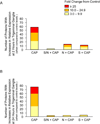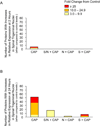Identification of cytokines and signaling proteins differentially regulated by sumatriptan/naproxen
- PMID: 22150557
- PMCID: PMC3277868
- DOI: 10.1111/j.1526-4610.2011.02048.x
Identification of cytokines and signaling proteins differentially regulated by sumatriptan/naproxen
Abstract
Objectives: The goal of this study was to use protein array analysis to investigate temporal regulation of stimulated cytokine expression in trigeminal ganglia and the spinal trigeminal nucleus in response to co-treatment of sumatriptan and naproxen sodium or individual drug.
Background: Activation of neurons and glia in trigeminal ganglia and the spinal trigeminal nucleus leads to increased levels of cytokines that promote peripheral and central sensitization, which are key events in migraine pathology. While recent clinical studies have provided evidence that a combination of sumatriptan and naproxen sodium is more efficacious in treating migraine than either drug alone, it is not well understood why the combination therapy is superior to monotherapy.
Methods: Male Sprague-Dawley rats were left untreated (control), injected with capsaicin, or pretreated with sumatriptan/naproxen, sumatriptan, or naproxen for 1 hour prior to capsaicin. Trigeminal ganglia and the spinal trigeminal nucleus were isolated 2 and 24 hours after capsaicin or drug treatment, and levels of 90 proteins were determined using a RayBio® Label-Based Rat Antibody Array (RayBiotech, Norcross, GA, USA).
Results: Capsaicin stimulated a >3-fold increase in expression of the majority of cytokines in trigeminal ganglia at 2 hours that was sustained at 24 hours. Significantly, treatment with sumatriptan/naproxen almost completely abolished the stimulatory effects of capsaicin at 2 and 24 hours. Capsaicin stimulated >3-fold expression of more proteins in the spinal trigeminal nucleus at 24 hours when compared to 2 hours. Similarly, sumatriptan/naproxen abolished capsaicin stimulation of proteins in the spinal trigeminal nucleus at 2 hours and greatly suppressed protein expression 24 hours post-capsaicin injection. Interestingly, treatment with sumatriptan alone suppressed expression of different cytokines in trigeminal ganglia and the spinal trigeminal nucleus than repressed by naproxen sodium.
Conclusion: We found that the combination of sumatriptan/naproxen was effective in blocking capsaicin stimulation of pro-inflammatory proteins implicated in the development of peripheral and central sensitization in response to capsaicin activation of trigeminal neurons. Based on our findings that sumatriptan and naproxen regulate expression of different proteins in trigeminal ganglia and the spinal trigeminal nucleus, we propose that these drugs function on therapeutically distinct cellular targets to suppress inflammation and pain associated with migraine.
© 2011 American Headache Society.
Conflict of interest statement
Conflict of Interest: Paul L Durham has received grant funding from GlaxoSmithKline. Carrie V Vause has no conflicts of interest to report.
Figures


Similar articles
-
Sumatriptan inhibits TRPV1 channels in trigeminal neurons.Headache. 2012 May;52(5):773-84. doi: 10.1111/j.1526-4610.2011.02053.x. Epub 2012 Jan 30. Headache. 2012. PMID: 22289052 Free PMC article.
-
Neuron-glia signaling in trigeminal ganglion: implications for migraine pathology.Headache. 2007 Jul-Aug;47(7):1008-23; discussion 24-5. doi: 10.1111/j.1526-4610.2007.00854.x. Headache. 2007. PMID: 17635592 Free PMC article.
-
Sumatriptan/naproxen sodium combination for the treatment of migraine.Expert Rev Neurother. 2008 Sep;8(9):1289-97. doi: 10.1586/14737175.8.9.1289. Expert Rev Neurother. 2008. PMID: 18759540 Review.
-
Sumatriptan-naproxen fixed combination for acute treatment of migraine: a critical appraisal.Drug Des Devel Ther. 2010 Feb 18;4:9-17. doi: 10.2147/dddt.s8410. Drug Des Devel Ther. 2010. PMID: 20368903 Free PMC article. Review.
-
Tonabersat inhibits trigeminal ganglion neuronal-satellite glial cell signaling.Headache. 2009 Jan;49(1):5-20. doi: 10.1111/j.1526-4610.2008.01262.x. Headache. 2009. PMID: 19125874 Free PMC article.
Cited by
-
Sumatriptan ameliorates renal injury induced by cisplatin in mice.Iran J Basic Med Sci. 2019 May;22(5):563-567. doi: 10.22038/ijbms.2019.33620.8020. Iran J Basic Med Sci. 2019. PMID: 31217938 Free PMC article.
-
Nicotine stimulates expression of proteins implicated in peripheral and central sensitization.Neuroscience. 2015 Apr 2;290:115-25. doi: 10.1016/j.neuroscience.2015.01.034. Epub 2015 Jan 28. Neuroscience. 2015. PMID: 25637801 Free PMC article.
-
Sumatriptan/naproxen sodium: a review of its use in adult patients with migraine.Drugs. 2013 Aug;73(12):1339-55. doi: 10.1007/s40265-013-0099-y. Drugs. 2013. PMID: 23912627 Review.
-
Identifying a gene expression signature of cluster headache in blood.Sci Rep. 2017 Jan 11;7:40218. doi: 10.1038/srep40218. Sci Rep. 2017. PMID: 28074859 Free PMC article.
-
Serotonin, 5HT1 agonists, and migraine: new data, but old questions still not answered.Curr Opin Support Palliat Care. 2014 Jun;8(2):137-42. doi: 10.1097/SPC.0000000000000044. Curr Opin Support Palliat Care. 2014. PMID: 24670810 Free PMC article. Review.
References
-
- Goadsby P, Lipton R, Ferrari M. Migraine--current understanding and treatment. N Engl J Med. 2002;346:257–270. - PubMed
-
- Hargreaves RJ, Shepheard SL. Pathophysiology of migraine--new insights. Can J Neurol Sci. 1999;26 Suppl 3:S12–S19. - PubMed
-
- Pietrobon D. Migraine: new molecular mechanisms. Neuroscientist. 2005;11:373–386. - PubMed
-
- Burstein R. Deconstructing migraine headache into peripheral and central sensitization. Pain. 2001;89:107–110. - PubMed
Publication types
MeSH terms
Substances
Grants and funding
LinkOut - more resources
Full Text Sources

